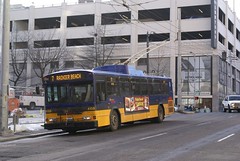With fuel prices going through the roof and the UTA having to consider a fuel surcharge due to those prices, is it time for transit systems such as the UTA to look at Trolley Buses again?
Trolley buses have been around almost since the time of the first streetcar, although the became very popular in the 30's and 40's but like streetcars disappeared by the 60's due to cheap diesel prices.
A few cities kept their Trolley buses including Vancouver, British Columbia; Edmonton, Alberta; Seattle, Washington; San Francisco, California; and Dayton, Ohio.
Los Angeles looked into starting new trolley bus routes in 1992 and 1993 but NIMBY's in one corner of the route decided they did not want the trolley buses in their neighborhood due to the wires, despite the fact it would have eliminated diesel exhaust from their neighborhood. Otherwise except for a few extensions of the San Francisco and Seattle systems there has been little thought about the trolley bus.
Besides NIMBYism, the other factor that kept new systems being put in was the initial capital cost and the higher price paid for trolley buses over standard buses.
Lets look at some of the advantages of trolley buses over standard buses:
-First of all they are quiet when compared to standard buses.
-Second, electrical components will last longer. About 5 years ago Seattle replaced their 25 year old trolley buses. However, they did not replace them with entirely new vehicles. While the bodies on the buses were worn out, the electrical components only needed refurbishing. So their ordered new bus bodies from Gillig (shown in the picture) and refurbished the electrical components thus getting new buses for substantially less than a new bus.
-Third, if a bus route has service of every 15-minutes or less trolley buses save money over diesel. Now that comes out of San Francisco with higher energy cost than Utah and back when diesel was down right cheap, so the cost savings would probably be even higher now. .
Disadvantages
-Buses are limited to routes with wires
-Need to have off-wire capability for emergencies such as road closures and other events that would cause them to have to "leave the wire".
Would Trolley Buses be more attractive to riders than standard diesel buses? They are quieter as noted so they actually could attract more riders but that cannot be quantified.
Instead of spending money on Bus Rapid Transit, putting money into Trolley buses could be an alternative worth looking at especially on the many UTA routes that now run every 15-minutes.

7 comments:
Here are a couple of public outreach videos created during the ill-fated Los Angeles trolley bus project:
http://www.youtube.com/watch?v=lZxAfJIv-P0
and
http://www.youtube.com/watch?v=5G8epBFeRh8
Trolleybuses? Bad idea. A trolleybus is still just a bus, and your transit authority would be better off building BRT-- at least the dedicated right of way could be converted to light rail fairly painlessly.
I'm from Seattle and almost all of the in-city routes are trolleys. They're particularly well-suited for hilly routes, which is one of the reasons both Seattle and San Francisco held on to their trolleys instead of going all-diesel. All the same, Seattleites had to fight to keep their trolleys when there was a move to go all-diesel back in the days when gas was dirt cheap.
Trolley buses are less well suited for less-dense suburban routes, due to the expense of adding substations - comparing them to BRT is comparing cumquats to bananas.
On other routes, Seattle is increasingly going to hybrid electric-diesel buses.
I'm from Portland, OR; and TRIMET considers installing some or all of the in-city routes are trolleys. Probably TRIMET will decide trolley assigns to well-suited for hilly routes. There still consider whether if trolley installs in their routes. I hope if Portland joins with Seattle and San Francisco; possible Salt Lake City joins them. TRIMET will decide about one of the reasons both Seattle and San Francisco held on to their trolleys instead of going some- or all-diesel.
Trolleybuses? Bad idea. A trolleybus is still just a bus, and your transit authority would be better off building BRT
We use to have several trolley bus routes up in Big Oil Edmonton Alberta Canada. But after years of using them as a witch hunt, The city scraper the system in 2009.
ETS routes 5 and 135 that had Electric Trolley buses running on them every 8 Minutes during the day.
Since they we have allready
have a service cuts and transit fairs increases, plus a tax increase in 2010. (about $149.xx per taxpayer, our population is about 1.1 Million). Each year when diesel full cost increases the end user will have to make up the difference.
** (When the total cost of a trolley bus route is cheaper then using diesel buses on it should not be used in the long term trolley buse should stay in service). Over head line manantance and the cost of electric power verses diesel.
Paying over double in fuel cost on routes 5 and 135 shows the no smarts at city hall.
Hopefully Seattle comes to its senses unlike in Edmonton.
If you read EPA enviromental reports you will find out how clean this old buggy technology
really is. (Still beats most newer diesel buses even when running off dirty coal fired power).
I totally support implementation of trolleybuses. It's time for Los Angeles to get real! Our current bus system is laughable. Slow, inefficient, unattractive, clumsy, noisy buses deter most Angelenos from trying mass transit. Trolleybuses would be a great solution.
Post a Comment